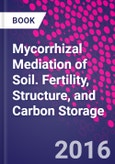Mycorrhizal Mediation of Soil: Fertility, Structure, and Carbon Storage offers a better understanding of mycorrhizal mediation that will help inform earth system models and subsequently improve the accuracy of global carbon model predictions. Mycorrhizas transport tremendous quantities of plant-derived carbon below ground and are increasingly recognized for their importance in the creation, structure, and function of soils. Different global carbon models vary widely in their predictions of the dynamics of the terrestrial carbon pool, ranging from a large sink to a large source.
This edited book presents a unique synthesis of the influence of environmental change on mycorrhizas across a wide range of ecosystems, as well as a clear examination of new discoveries and challenges for the future, to inform land management practices that preserve or increase below ground carbon storage.
Table of Contents
1. Mycorrhizas: At the Interface of Biological, Soil, and Earth Sciences
Section I. Mycorrhizal Mediation of Soil Development 2. Mycorrhizal Symbioses and Pedogenesis Throughout Earth's History 3. Role of Mycorrhizal Symbiosis in Mineral Weathering and Nutrient Mining from Soil Parent Material 4. Mycorrhizal Interactions With Climate, Soil Parent Material, and Topography 5. Mycorrhizas Across Successional Gradients
Section II. Mycorrhizal Mediation of Soil Fertility 6. Introduction: Perspectives on Mycorrhizas and Soil Fertility 7. Fungal and Plant Tools for the Uptake of Nutrients in Arbuscular Mycorrhizas: A Molecular View 8. Accessibility of Inorganic and Organic Nutrients for Mycorrhizas 9. Mycorrhizas as Nutrient and Energy Pumps of Soil Food Webs: Multitrophic Interactions and Feedbacks 10. Implications of Past, Current, and Future Agricultural Practices for Mycorrhiza-Mediated Nutrient Flux 11. Integrating Ectomycorrhizas Into Sustainable Management of Temperate Forests 12. Mycorrhizal Mediation of Soil Fertility Amidst Nitrogen Eutrophication and Climate Change
Section III. Mycorrhizal Mediation of Soil Structure And Soil-Plant Water Relations 13. Introduction: Mycorrhizas and Soil Structure, Moisture, and Salinity 14. Mycorrhizas and Soil Aggregation 15. Arbuscular Mycorrhizal Fungi and Soil Salinity 16. Mycorrhizas, Drought, and Host-Plant Mortality 17. Soil Water Retention and Availability as Influenced by Mycorrhizal Symbiosis: Consequences for Individual Plants, Communities, and Ecosystems 18. Mycorrhizal Networks and Forest Resilience to Drought
Section IV. Mycorrhizal Mediation of Ecosystem Carbon Fluxes and Soil Carbon Storage 19. Introduction: Mycorrhizas and the Carbon Cycle 20. Carbon and Energy Sources of Mycorrhizal Fungi: Obligate Symbionts or Latent Saprotrophs? 21. Magnitude, Dynamics, and Control of the Carbon Flow to Mycorrhizas 22. Trading Carbon Between Arbuscular Mycorrhizal Fungi and Their Hyphae-Associated Microbes 23. Immobilization of Carbon in Mycorrhizal Mycelial Biomass and Secretions 24. Mycorrhizal Interactions With Saprotrophs and Impact on Soil Carbon Storage 25. Biochar-Arbuscular Mycorrhiza Interaction in Temperate Soils 26. Integrating Mycorrhizas Into Global Scale Models: A Journey Toward Relevance in the Earth's Climate System








